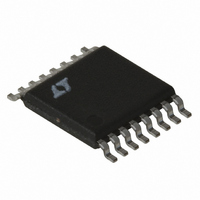LT3430EFE#TR Linear Technology, LT3430EFE#TR Datasheet - Page 12

LT3430EFE#TR
Manufacturer Part Number
LT3430EFE#TR
Description
IC REG SW 3A 200KHZ STDN 16TSSOP
Manufacturer
Linear Technology
Type
Step-Down (Buck)r
Datasheet
1.LT3430EFE-1PBF.pdf
(28 pages)
Specifications of LT3430EFE#TR
Internal Switch(s)
Yes
Synchronous Rectifier
No
Number Of Outputs
1
Voltage - Output
1.2 ~ 54 V
Current - Output
3A
Frequency - Switching
200kHz
Voltage - Input
5.5 ~ 60 V
Operating Temperature
-40°C ~ 125°C
Mounting Type
Surface Mount
Package / Case
16-TSSOP Exposed Pad, 16-eTSSOP, 16-HTSSOP
Lead Free Status / RoHS Status
Contains lead / RoHS non-compliant
Power - Output
-
Available stocks
Company
Part Number
Manufacturer
Quantity
Price
LT3430/LT3430-1
APPLICATIONS INFORMATION
Reduced Inductor Value and Discontinuous Mode
If the smallest inductor value is of most importance to a
converter design, in order to reduce inductor size/cost,
discontinuous mode may yield the smallest inductor solu-
tion. The maximum output load current in discontinuous
mode, however, must be calculated and is defi ned later
in this section.
Discontinuous mode is entered when the output load
current is less than one-half of the inductor ripple current
(I
the next switch turn on (see Figure 8). Buck converters
will be in discontinuous mode for output load current
given by:
I
The inductor value in a buck converter is usually chosen
large enough to keep inductor ripple current (I
this is done to minimize output ripple voltage and maximize
output load current. In the case of large inductor values,
as seen in the equation above, discontinuous mode will
be associated with “light loads.”
When choosing small inductor values, however, discontinu-
ous mode will occur at much higher output load currents.
The limit to the smallest inductor value that can be chosen
is set by the LT3430/LT3430-1 peak switch current (I
the maximum output load current required, given by:
Example: For V
and L = 4.7µH.
12
OUT
LP-P
Discontinuous Mode
I
Discontinuous Mode
=
=
OUT(MAX)
). In this mode, inductor current falls to zero before
( )(
2
2
(
V
I
OUT
I
P
LP-P
2
+
I
)
P
IN
V V
2
F
(
= 15V, V
)(
f L V
• •
IN
–
IN
<
= <
V
OUT
OUT
)
(
V
OUT
I
= 5V, V
LP-P
–
2
V
+
F
( )(
)
V V
2
F
F
= 0.52V, f = 200kHz
)(
V
IN
IN
)( )( )
–
f L
V
OUT
LP-P
P
–
) low;
) and
V
F
)
What has been shown here is that if high inductor ripple
current and discontinuous mode operation can be tolerated,
small inductor values can be used. If a higher output load
current is required, the inductor value must be increased.
If I
criteria, use the I
the LT3430/LT3430-1 are designed to operate well in both
modes of operation, allowing a large range of inductor
values to be used.
Short-Circuit Considerations
The LT3430/LT3430-1 are current mode controllers. They
use the V
tor which turns off the output switch on a cycle-by-cycle
basis as this peak current is reached. The internal clamp on
the V
peak current limit. This action becomes the switch current
limit specifi cation. The maximum available output power
is then determined by the switch current limit.
A potential controllability problem could occur under
short-circuit conditions. If the power supply output is
short circuited, the feedback amplifi er responds to the
low output voltage by raising the control voltage, V
peak current limit value. Ideally, the output switch would
be turned on, and then turned off as its current exceeded
the value indicated by V
time involved in both the current comparator and turnoff
of the output switch. These result in a minimum on time
t
(V
voltage drop, the potential exists for a loss of control.
Expressed mathematically the requirement to maintain
control is:
ON(MIN)
F
I
Discontinuous
Mode
I
Discontinuous Mode
f t
OUT(MAX)
OUT(MAX)
OUT(MAX)
+ I • R), the diode forward voltage plus inductor I • R
•
C
ON
node, nominally 2V, then acts as an output switch
. When combined with the large ratio of V
C
≤
node voltage as an input to a current compara-
V
no longer meets the discontinuous mode
F
V
+
IN
OUT(MAX)
I R
•
=
3
2
C
2 5 0 52 15 5 0 52
. However, there is fi nite response
• (
= 1.21A
(
200 10
equation for continuous mode;
+
•
. )( – – . )
3
)( . •
4 7 10
−
6
)( )
15
C
IN
, to its
34301fa
to













